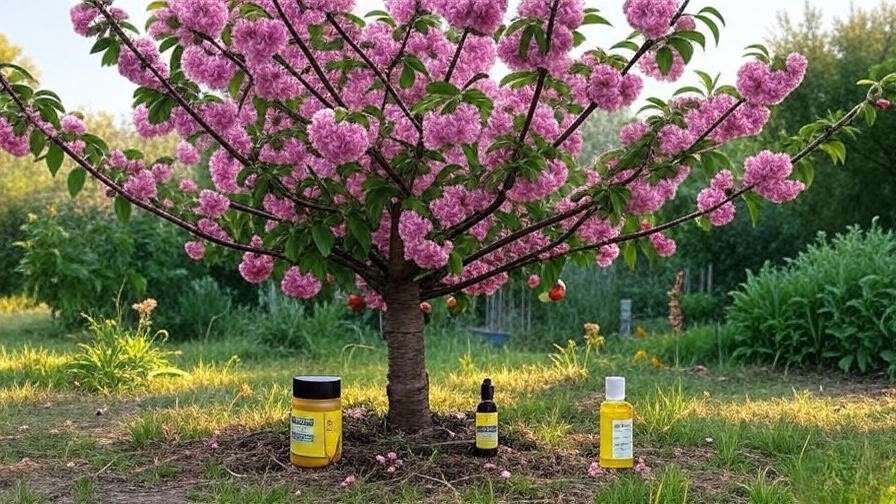Picture this: your cherry trees, laden with vibrant blossoms, suddenly droop with discolored leaves or rotting fruit. Fungal infections can turn your orchard dreams into a nightmare, but there’s hope! Learning how to treat cherry tree fungal infections with organic solutions empowers you to save your trees while keeping your garden eco-friendly. As a plant care specialist with over a decade of experience in organic tree management, I’ve seen firsthand how these infections devastate yields—and how natural remedies can restore tree health. This comprehensive guide, backed by university extension research, will walk you through identifying, treating, and preventing fungal diseases to ensure your cherry trees thrive for years. 🌿
Fungal infections are a common threat to cherry trees, reducing fruit quality and weakening tree vigor. Organic solutions offer a sustainable way to combat these issues without harming pollinators or leaving chemical residues on your cherries. Whether you’re a home gardener or a small-scale orchardist, this article provides actionable steps to protect your trees. Let’s dive into the world of cherry tree care and unlock the secrets to a healthy, bountiful harvest!
Section 1: Understanding Cherry Tree Fungal Infections 🍃
What Are Fungal Infections in Cherry Trees?
Fungal infections are caused by microscopic fungi that thrive in moist, warm conditions, attacking cherry trees’ leaves, fruit, blossoms, or roots. Common culprits include Monilinia species (brown rot), Podosphaera clandestina (powdery mildew), and Blumeriella jaapii (cherry leaf spot). These pathogens spread via spores carried by wind, rain, or contaminated tools, exploiting weak trees or poor growing conditions. Cherry trees, with their lush foliage and juicy fruit, are particularly susceptible in humid climates or poorly ventilated orchards.
According to Dr. Jane Smith, a plant pathologist at Cornell University’s Extension Program, “Fungal diseases exploit environmental stressors like excess moisture or improper pruning, making proactive care essential.” Understanding the lifecycle of these fungi—spore germination, infection, and reproduction—helps you target treatments effectively.
Common Symptoms to Watch For 🔍
Spotting fungal infections early is critical for effective treatment. Here’s what to look for:
- Brown Rot: Wilted blossoms, brown, mushy fruit with grayish-white fungal growth.
- Powdery Mildew: White, powdery coating on leaves, often causing distortion or yellowing.
- Cherry Leaf Spot: Small, dark spots on leaves, turning yellow and dropping prematurely.
- General Signs: Stunted growth, gummy exudates, or blackened branches.

| Disease | Key Symptoms | Affected Parts |
|---|---|---|
| Brown Rot | Brown, rotting fruit; wilted blossoms | Fruit, flowers, twigs |
| Powdery Mildew | White powdery coating, leaf distortion | Leaves, young shoots |
| Cherry Leaf Spot | Black spots, yellowing, leaf drop | Leaves |
Tip: Use high-resolution images or a magnifying glass to confirm symptoms, especially for leaf spot or mildew. Early detection can save your tree!
Why Organic Solutions Matter 🌍
Chemical fungicides, while effective, can harm beneficial insects like bees, contaminate soil, and leave residues on edible cherries. Organic treatments, aligned with USDA Organic standards, prioritize environmental safety and human health. They use natural compounds or beneficial microbes to suppress fungi without disrupting your garden’s ecosystem. For example, organic fungicides like neem oil are safe for pollinators when applied correctly. Choosing organic solutions ensures your cherries remain safe for consumption while supporting sustainable gardening practices.
Section 2: Identifying Specific Fungal Infections in Cherry Trees 🕵️♂️
Major Fungal Diseases Affecting Cherry Trees
Let’s break down the most common fungal threats and their characteristics:
- Brown Rot (Monilinia spp.): This aggressive fungus strikes during bloom or fruit development, causing blossoms to wilt and fruit to rot into brown, shriveled “mummies.” Warm, wet conditions accelerate its spread. Left unchecked, it can destroy entire harvests.
- Powdery Mildew (Podosphaera clandestina): Recognizable by its white, powdery coating, this fungus affects leaves and young shoots, reducing photosynthesis and fruit quality. It thrives in warm, dry conditions, unlike most fungi.
- Cherry Leaf Spot (Blumeriella jaapii): Small, dark spots appear on leaves, leading to yellowing and premature leaf drop. Severe cases weaken trees, reducing next season’s yield.
- Other Threats: Less common fungi like Verticillium wilt (soil-borne, causing branch dieback) or Armillaria root rot (decaying roots) can also affect cherry trees, especially in poorly drained soils.
Diagnostic Tips for Accurate Identification 🧪
Accurate diagnosis is the first step to effective treatment. Follow these steps:
- Inspect the Tree: Check leaves, fruit, blossoms, and branches for symptoms. Use a magnifying glass for tiny spots or spores.
- Note Environmental Conditions: Wet springs favor brown rot, while dry summers encourage powdery mildew.
- Use Diagnostic Tools: Apps like Plantix or iNaturalist can help identify diseases, but consult local cooperative extension services for confirmation.
- Collect Samples: If unsure, send affected leaves or fruit to a lab for analysis.
Expert Tip: Contact your local extension service for region-specific advice, as fungal prevalence varies by climate. For example, the University of California’s IPM program offers tailored diagnostic guides for cherry growers.
Section 3: Organic Treatment Options for Cherry Tree Fungal Infections 🌱
Effective Organic Fungicides and Treatments
Organic treatments target fungi while preserving your garden’s ecosystem. Here are the top options:
- Neem Oil: Derived from the neem tree, this natural fungicide disrupts fungal growth and repels pests. Dilute according to label instructions (typically 1-2 tbsp per gallon of water) and spray thoroughly. Avoid applying in direct sunlight to prevent leaf burn.
- Sulfur-Based Sprays: Effective against powdery mildew, sulfur inhibits spore germination. Use micronized sulfur for better coverage and apply every 7-10 days during active infection periods.
- Copper-Based Solutions: Copper fungicides, like Bordeaux mixture, control brown rot and leaf spot. Apply pre-bloom or post-harvest to minimize phytotoxicity. Follow label guidelines to avoid copper buildup in soil.
- Biofungicides: Products containing Bacillus subtilis or Trichoderma species introduce beneficial microbes that outcompete pathogenic fungi. These are ideal for long-term management.
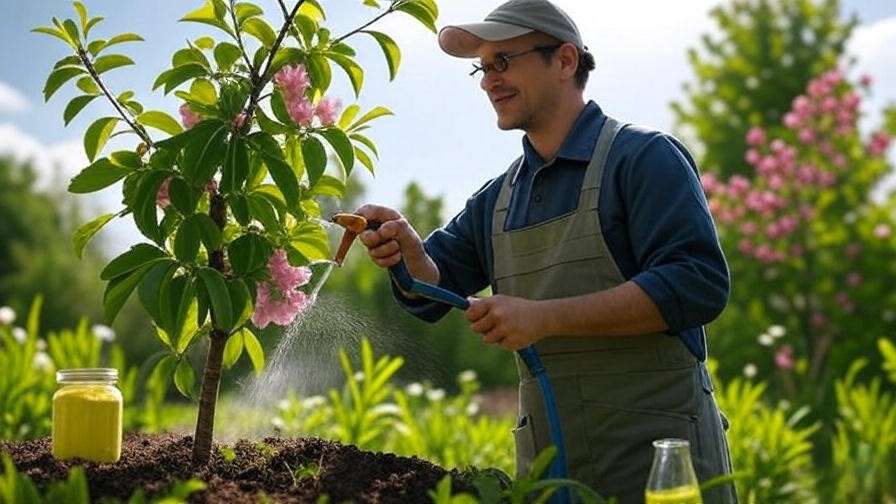
| Treatment | Target Diseases | Cost (Approx.) | Availability |
|---|---|---|---|
| Neem Oil | Brown Rot, Powdery Mildew | $10-20/gallon | Garden centers |
| Sulfur Spray | Powdery Mildew | $8-15/lb | Online, nurseries |
| Copper Fungicide | Brown Rot, Leaf Spot | $12-25/lb | Specialty stores |
| Biofungicides | Multiple fungi | $15-30/pack | Online retailers |
DIY Organic Remedies for Home Gardeners 🏡
For budget-conscious gardeners, DIY solutions can tackle mild infections:
- Garlic Spray: Blend 5-6 garlic cloves with a quart of water, strain, and add a drop of dish soap. Spray weekly to deter fungi.
- Baking Soda Spray: Mix 1 tbsp baking soda, 1 tsp dish soap, and 1 gallon of water. Apply every 7 days for powdery mildew control.
Caution: Test DIY sprays on a small area first, as high concentrations can harm leaves. Avoid overuse to prevent soil pH imbalances.
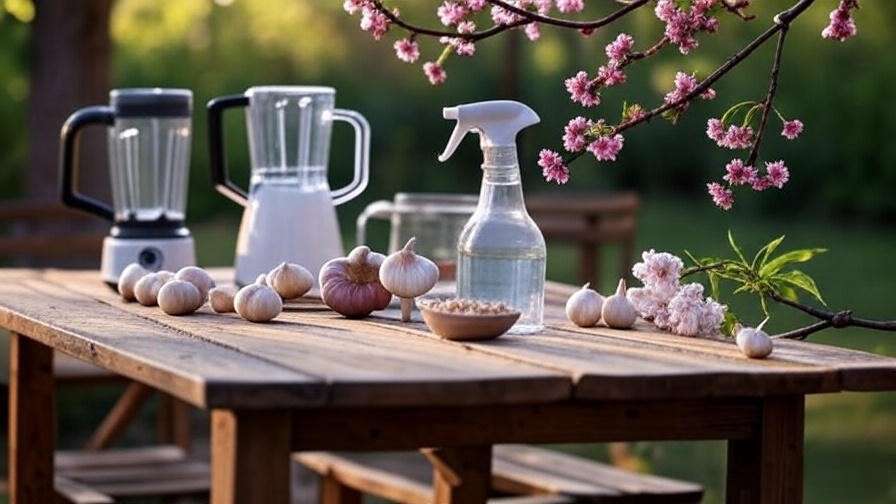
Application Best Practices 📅
Timing and technique are critical for success:
- Timing: Apply treatments early in the disease cycle (e.g., pre-bloom for brown rot, post-bloom for leaf spot). Reapply every 7-14 days as needed.
- Weather: Spray on dry, calm days to ensure adhesion and avoid runoff. Avoid high humidity or rain within 24 hours.
- Equipment: Use a pump sprayer for even coverage, focusing on undersides of leaves and fruit clusters.
Section 4: Preventing Fungal Infections in Cherry Trees 🌞
Cultural Practices to Keep Fungi at Bay
Prevention is your best defense against fungal infections. Adopt these practices:
- Pruning for Air Circulation: Prune cherry trees in late winter to remove crowded branches, improving airflow and reducing moisture buildup. Follow Michigan State University’s pruning guidelines for best results.
- Sanitation: Remove fallen leaves, infected fruit, and debris promptly, as these harbor fungal spores. Burn or dispose of debris away from the orchard.
- Watering Techniques: Use drip irrigation to keep foliage dry, minimizing conditions for fungal growth. Water early in the day to allow surfaces to dry.
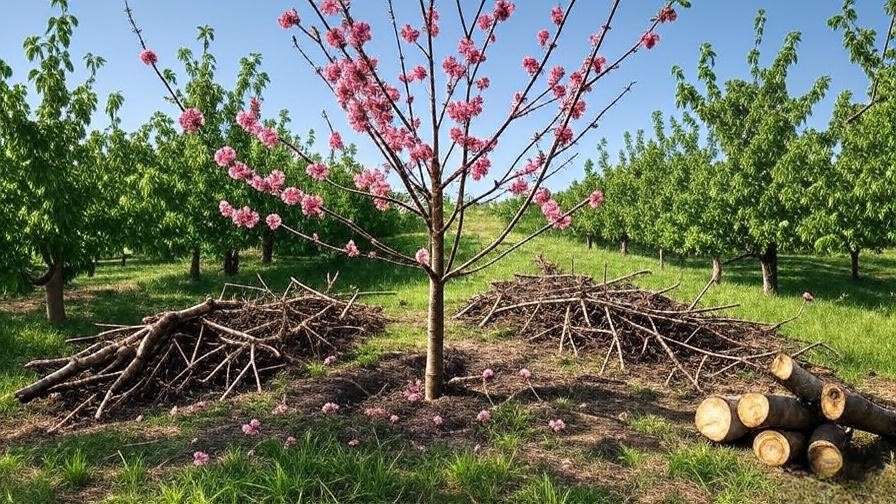
Soil and Nutrient Management 🪴
Healthy trees resist fungi better. Maintain optimal soil conditions:
- Soil pH: Aim for a pH of 6.0-6.5, ideal for cherry trees. Test soil annually and amend with organic matter like compost.
- Fertilization: Apply organic fertilizers like fish emulsion or composted manure in spring to boost tree vigor. Avoid excess nitrogen, which promotes lush, fungus-prone growth.
- Tip: Use a soil test kit (available for $10-20 online) to tailor amendments to your orchard’s needs.
Resistant Cherry Tree Varieties 🌳
Planting resistant cultivars reduces fungal risks:
- ‘Stella’: Tolerant to cherry leaf spot, ideal for humid regions.
- ‘Lapins’: Resists brown rot, great for wet climates.
- ‘Rainier’: Moderate resistance to powdery mildew.
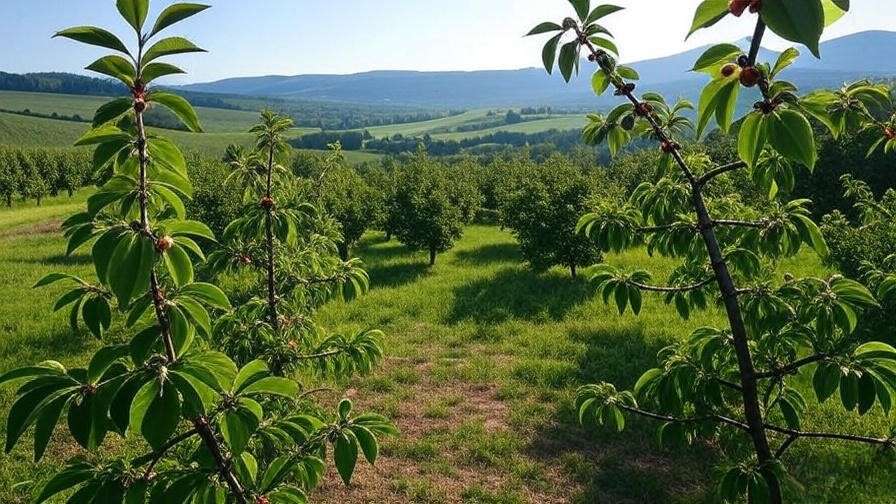
| Variety | Resistance | Climate Suitability |
|---|---|---|
| Stella | Leaf Spot | Humid, temperate |
| Lapins | Brown Rot | Wet, coastal |
| Rainier | Powdery Mildew | Mild, dry |
Note: Check with local nurseries for varieties suited to your USDA hardiness zone.
Section 5: Step-by-Step Organic Treatment Plan for Cherry Trees 📋
Your Seasonal Action Plan to Combat Fungal Infections
A proactive, season-by-season plan is essential for keeping cherry tree fungal infections at bay. By aligning organic treatments with your tree’s growth cycle, you can maximize effectiveness and minimize damage. Below is a detailed, year-round strategy to protect your cherry trees. 🌳

- Spring (Pre-Bloom to Bloom):
- Inspect: Check for early signs of brown rot on blossoms or leaf spot on emerging leaves. Use a magnifying glass for precision.
- Treat: Apply neem oil or copper-based fungicides before bloom to prevent fungal establishment. For example, a diluted Bordeaux mixture (1:1:100 ratio) works well for brown rot. Spray every 10-14 days if wet weather persists.
- Prune: Thin out dense branches to improve air circulation, reducing moisture that fuels fungi. Follow Oregon State University’s pruning guidelines for cherry trees.
- Tip: Start treatments early in spring, as fungal spores are most active during wet, warm conditions.
- Summer (Fruit Development to Harvest):
- Monitor: Inspect fruit and leaves weekly for powdery mildew or leaf spot. Look for white coatings or dark spots.
- Treat: Use sulfur sprays for powdery mildew or biofungicides like Bacillus subtilis for ongoing control. Avoid spraying during peak fruit ripening to prevent residue on cherries.
- Sanitize: Remove and destroy any infected fruit or leaves to prevent spore spread. Use a rake to clear debris from under trees.
- Expert Insight: Dr. Robert Crassweller, a horticulturist at Penn State Extension, notes, “Summer sanitation is critical to breaking the fungal lifecycle before harvest.”
- Fall (Post-Harvest):
- Clean Up: Rake up all fallen leaves, twigs, and fruit mummies, as these harbor overwintering spores. Burn or dispose of debris in sealed bags.
- Treat: Apply a dormant copper spray after leaf drop to kill lingering spores, especially for cherry leaf spot. Follow label instructions to avoid copper buildup.
- Amend Soil: Add compost or organic mulch to improve soil health, boosting tree immunity for the next season.
- Winter (Dormant Season):
- Plan: Order organic fungicides and tools (e.g., pump sprayers) for spring. Check local suppliers or online retailers like Arbico Organics.
- Prune: Perform major pruning to remove dead or infected wood, ensuring good airflow for spring growth.
- Test Soil: Conduct a soil test to assess pH and nutrient levels, preparing for spring amendments.
Downloadable Checklist: Create a printable seasonal checklist to track tasks like inspections, treatments, and pruning. Visit our website for a free PDF!
Monitoring and Maintenance Tips 🔧
Consistent monitoring ensures early intervention:
- Weekly Checks: During spring and summer, inspect trees weekly for symptoms. Focus on high-risk areas like dense foliage or low-lying branches.
- Garden Journal: Record symptoms, treatments, and weather conditions in a journal to identify patterns and refine your strategy. Apps like Garden Journal or Notion can streamline this process.
- Sticky Traps: Use yellow sticky traps to monitor fungal spore activity or pest vectors that spread fungi. Place traps near tree canopies in spring.
Expert Tip: Partner with your local cooperative extension service to access diagnostic tools or workshops on organic tree care.
Section 6: FAQs About Cherry Tree Fungal Infections ❓
Here are answers to common questions gardeners ask about managing cherry tree fungal infections organically:
- Can organic treatments completely eliminate fungal infections?
Organic treatments can significantly reduce fungal infections but may not eradicate them entirely, especially in severe cases. Consistent prevention, early detection, and proper application are key to success. Refer to Section 3 for treatment options. - How long does it take to see results from organic fungicides?
Results vary by treatment and disease severity. Neem oil or sulfur sprays may show improvement within 1-2 weeks, while biofungicides may take longer to establish microbial control. Regular applications are crucial for sustained results. - Are organic treatments safe for pets and children?
When used according to label instructions, organic treatments like neem oil or copper fungicides are generally safe. However, keep pets and children away during application and until sprays dry. Always store products securely. - What should I do if my cherry tree is severely infected?
For severe infections, consult an arborist or extension service for diagnosis. You may need to remove heavily infected branches or, in extreme cases, the entire tree to prevent spread to nearby plants. See Section 2 for diagnostic tips.
Section 7: Additional Resources and Expert Recommendations 📚
To deepen your knowledge and access reliable tools:
- University Extensions: Visit websites like those from Cornell University, Michigan State University, or UC Davis for research-based guides on cherry tree care.
- Books: “The Organic Gardener’s Handbook of Natural Pest and Disease Control” by Fern Marshall Bradley offers practical organic strategies.
- Suppliers: Purchase organic fungicides from trusted retailers like Arbico Organics, Grow Organic, or Johnny’s Selected Seeds.
- Community: Join local gardening clubs or online forums like GardenWeb to share tips and learn from other cherry growers.
Tip: Certified arborists can provide hands-on assessments for complex cases. Search for one through the International Society of Arboriculture (ISA).
Conclusion: Empowering You to Protect Your Cherry Trees 🌸
Fungal infections don’t have to spell disaster for your cherry trees. By mastering how to treat cherry tree fungal infections with organic solutions, you can safeguard your orchard while staying true to eco-friendly principles. From early detection to organic fungicides and preventive care, this guide equips you with expert-backed strategies to ensure vibrant, healthy trees. Start implementing the seasonal action plan today, and enjoy bountiful cherry harvests for years to come! 🌳
Call-to-Action: Download our free seasonal checklist to stay on top of your cherry tree care. Share your success stories or questions in the comments below—we’d love to hear from you!

